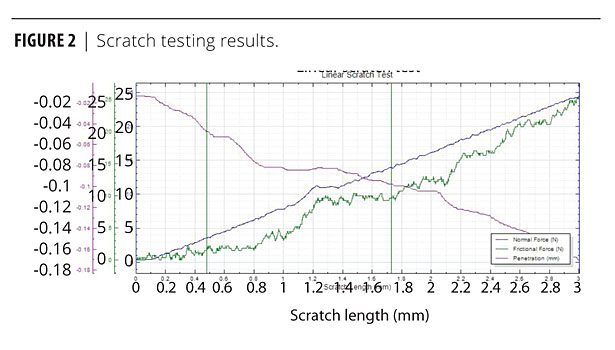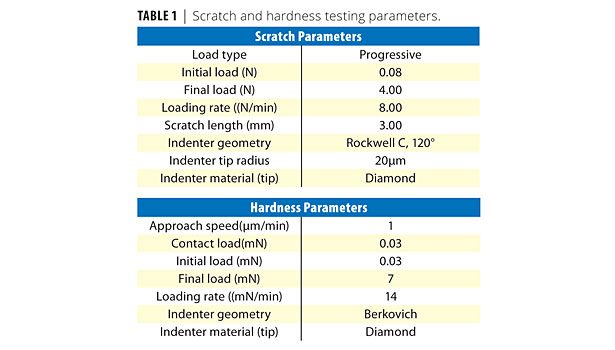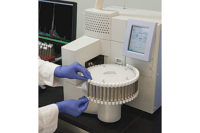Micro Scratch Testing










Two main causes of damage are either when the pill is travelling on the metallic conveyer or when the pill is inside the container and is in contact with other tablets. The coating must withstand the process of conveying and packaging with minimal failure while maintaining ingestion requirements. The reliability of the tablet coating process is critical to existing tablet production and will be more demanding with new or improved pharmaceutical coatings.
Importance of Micro Scratch Testing for Quality Control
A major concern for pharmaceutical tablet manufacturers is to ensure strong coating adhesion and/or the ability to withstand marring/cracking. A tablet coating that loses adhesion and/or begins to crack is a serious product failure when thousands of tablets are being coated. As tablet medication continues to grow, quality assurance plays a crucial role in establishing a reliable coating process. Although adhesion failure and/or cracking failure may be inevitable or even intended over time, it is crucial that these failures are investigated, known and controlled. Using the Micro Scratch Test, precisely controlled loads can be used to investigate tablet coatings for these very failures.
Measurement Objective
We must simulate the process of scratching in a controlled and monitored manner to observe sample behavior effects. In this application, the Nanovea Mechanical Tester, in its micro scratch mode, is used to measure the load required to cause the failure to a generic and brand tablet coating. A 20 µm diamond-tipped stylus is used at a progressive load ranging from 4 N to 8 N to scratch the tablet coating. The point where the coating fails by cracking is taken as the point of failure. Hardness and elastic modulus is also evaluated in the nano-indentation mode.
Measurement Principle
The scratch testing method is a very reproducible, quantitative technique in which critical loads at which failures appear are used to compare the cohesive or adhesive properties of coatings or bulk materials. During the test, scratches are made on the sample with a sphero-conical stylus (tip radius ranging from 1 to 20 mm), which is drawn at a constant speed across the sample, under a constant load, or, more commonly, a progressive load with a fixed loading rate. A sphero-conical stylus is available with different radii, which describe the “sharpness” of the stylus. Common radii range from 20 to 200 mm for micro/macro scratch tests, and 1 to 20 mm for nano scratch tests.
When performing a progressive load test, the critical load is defined as the smallest load at which a recognizable failure occurs. In the case of a constant load test, the critical load corresponds to the load at which a regular occurrence of such failure along the track is observed. In the case of bulk materials, the critical loads observed are cohesive failures, such as cracking, or plastic deformation of the material. In the case of coated tablet samples, the lower load regime results in conformal or tensile cracking of the coating, which still remains fully adherent (which usually defines the first critical load). In the higher load regime, further damage usually comes from coating detachment from the substrate by spalling, buckling or chipping (Figure 1).
The Critical Load
The scratch test gives very reproducible, quantitative data that can be used to compare the behavior of various coatings. The critical loads depend on the mechanical strength (adhesion, cohesion) of a coating/substrate composite but also on several other parameters: some of them are directly related to the test itself, while others are related to the coating/substrate system.
The test-specific parameters include:
• Loading rate;
• Scratching speed;
• Indenter tip radius; and
• Indenter material.
The sample-specific parameters include:
• Friction coefficient between surface and indenter;
• Internal stresses in the material;
For bulk materials
• Material hardness and roughness;
For coating-substrate systems
• Substrate hardness and roughness;
• Coating hardness and roughness; and
• Coating thickness.
Critical Load Determination Analysis Techniques
Microscopic Observation
This is the most reliable method to detect surface damage. This technique is able to differentiate between cohesive failure within the coating and adhesive failure at the interface of the coating/substrate system.
Tangential (Frictional) Force Recording
This enables the force fluctuations along the scratch to be studied and correlated to the failures observed under the microscope. Typically, a failure in the sample will result in a change (a step, or a change in slope) in coefficient of friction. Frictional responses to failures are very specific to the coating/substrate system under study.
Acoustic Emission (AE) Detection
AE is used to detect elastic waves generated as a result of the formation and propagation of microcracks. The AE sensor is insensitive to mechanical vibration frequencies of the instrument. This method of critical load determination is mostly adequate for hard coatings that crack with more energy.
Depth Sensing
Sudden change in the depth data can indicate delimitation. Depth information pre and post scratch can also give information on plastic versus elastic deformation during the test. 3D noncontact imaging, such as the white light axial chromatism technique and AFM, can be useful to measure the exact scratch depth after testing.
Test Parameters and Results
Table 1 contains the parameters used for both the scratch and hardness testing. Scratch testing results are illustrated in Figure 2. Micrographs of the failures for the generic and brand tablet are shown in Figure 3. Hardness results are shown in Table 2.
Conclusion
From the hardness testing data, we see that the generic tablet is covered by a softer and more elastic coating. During scratch testing the failure seen on the generic tablet shows how the more elastic coating fully delaminates by ripping open at 2 N. The coating on the brand tablet is much harder and more brittle. During scratch testing the brand coating fails with cracking and chipping at 0.6 N. Here the harder coating is pushed into the soft substrate indicated by the exposure of substrate on each side of the scratch. Visually the failure will be more apparent at over 2 N on the generic sample than the brand sample. This is a typical scenario when comparing soft vs. brittle coatings on a soft substrate.
As shown, the value of micro scratch testing for tablet coatings is the ability to quantify with superior repeatability the adhesion (adhesive failure) and cracking (cohesive failure) of the tablet coatings. There are many indenter tips that can be used to simulate various scratch levels. Additionally, the Nanovea Mechanical Tester could have also been used to measure wear, friction coefficient, compression, fracture toughness, roughness and other parameters. It is a complete and powerful tool for tablet coating research and control.
For more information, visit www.nanovea.com/MechanicalTesters.html.
Looking for a reprint of this article?
From high-res PDFs to custom plaques, order your copy today!












